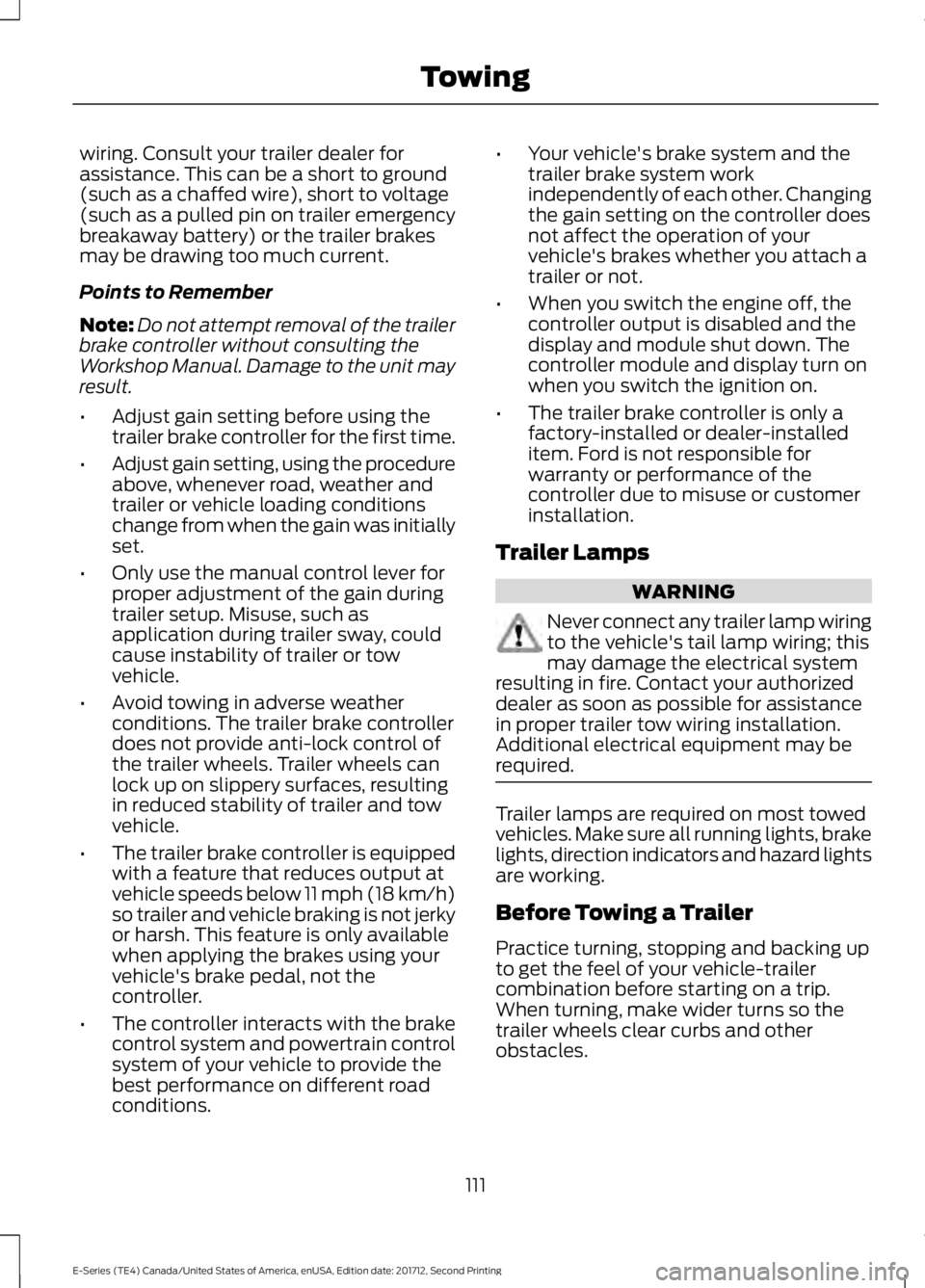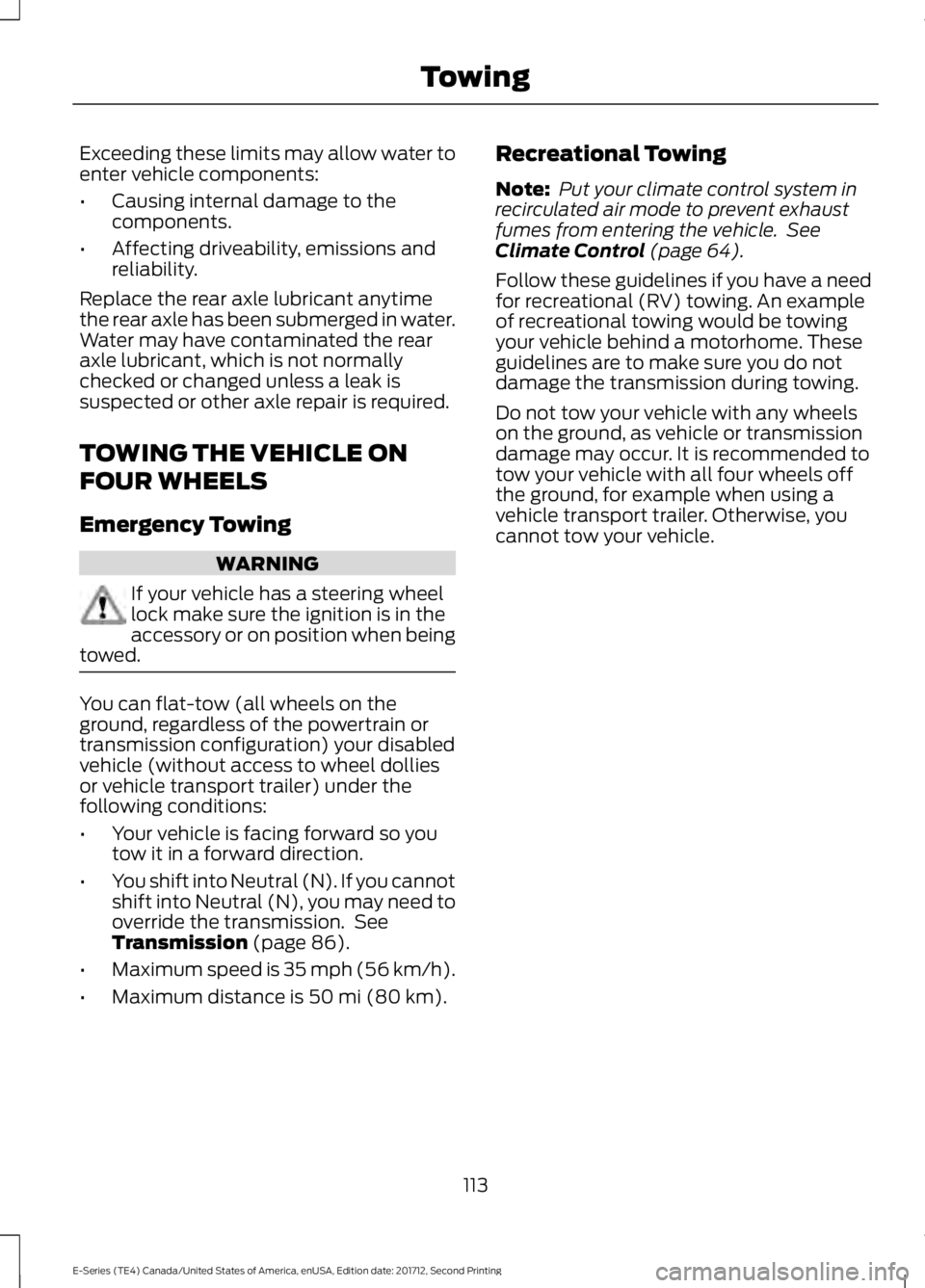2018 FORD E-350 emergency towing
[x] Cancel search: emergency towingPage 114 of 323

wiring. Consult your trailer dealer for
assistance. This can be a short to ground
(such as a chaffed wire), short to voltage
(such as a pulled pin on trailer emergency
breakaway battery) or the trailer brakes
may be drawing too much current.
Points to Remember
Note:
Do not attempt removal of the trailer
brake controller without consulting the
Workshop Manual. Damage to the unit may
result.
• Adjust gain setting before using the
trailer brake controller for the first time.
• Adjust gain setting, using the procedure
above, whenever road, weather and
trailer or vehicle loading conditions
change from when the gain was initially
set.
• Only use the manual control lever for
proper adjustment of the gain during
trailer setup. Misuse, such as
application during trailer sway, could
cause instability of trailer or tow
vehicle.
• Avoid towing in adverse weather
conditions. The trailer brake controller
does not provide anti-lock control of
the trailer wheels. Trailer wheels can
lock up on slippery surfaces, resulting
in reduced stability of trailer and tow
vehicle.
• The trailer brake controller is equipped
with a feature that reduces output at
vehicle speeds below 11 mph (18 km/h)
so trailer and vehicle braking is not jerky
or harsh. This feature is only available
when applying the brakes using your
vehicle's brake pedal, not the
controller.
• The controller interacts with the brake
control system and powertrain control
system of your vehicle to provide the
best performance on different road
conditions. •
Your vehicle's brake system and the
trailer brake system work
independently of each other. Changing
the gain setting on the controller does
not affect the operation of your
vehicle's brakes whether you attach a
trailer or not.
• When you switch the engine off, the
controller output is disabled and the
display and module shut down. The
controller module and display turn on
when you switch the ignition on.
• The trailer brake controller is only a
factory-installed or dealer-installed
item. Ford is not responsible for
warranty or performance of the
controller due to misuse or customer
installation.
Trailer Lamps WARNING
Never connect any trailer lamp wiring
to the vehicle's tail lamp wiring; this
may damage the electrical system
resulting in fire. Contact your authorized
dealer as soon as possible for assistance
in proper trailer tow wiring installation.
Additional electrical equipment may be
required. Trailer lamps are required on most towed
vehicles. Make sure all running lights, brake
lights, direction indicators and hazard lights
are working.
Before Towing a Trailer
Practice turning, stopping and backing up
to get the feel of your vehicle-trailer
combination before starting on a trip.
When turning, make wider turns so the
trailer wheels clear curbs and other
obstacles.
111
E-Series (TE4) Canada/United States of America, enUSA, Edition date: 201712, Second Printing Towing
Page 116 of 323

Exceeding these limits may allow water to
enter vehicle components:
•
Causing internal damage to the
components.
• Affecting driveability, emissions and
reliability.
Replace the rear axle lubricant anytime
the rear axle has been submerged in water.
Water may have contaminated the rear
axle lubricant, which is not normally
checked or changed unless a leak is
suspected or other axle repair is required.
TOWING THE VEHICLE ON
FOUR WHEELS
Emergency Towing WARNING
If your vehicle has a steering wheel
lock make sure the ignition is in the
accessory or on position when being
towed. You can flat-tow (all wheels on the
ground, regardless of the powertrain or
transmission configuration) your disabled
vehicle (without access to wheel dollies
or vehicle transport trailer) under the
following conditions:
•
Your vehicle is facing forward so you
tow it in a forward direction.
• You shift into Neutral (N). If you cannot
shift into Neutral (N), you may need to
override the transmission. See
Transmission (page 86).
• Maximum speed is 35 mph (56 km/h).
• Maximum distance is
50 mi (80 km). Recreational Towing
Note:
Put your climate control system in
recirculated air mode to prevent exhaust
fumes from entering the vehicle. See
Climate Control
(page 64).
Follow these guidelines if you have a need
for recreational (RV) towing. An example
of recreational towing would be towing
your vehicle behind a motorhome. These
guidelines are to make sure you do not
damage the transmission during towing.
Do not tow your vehicle with any wheels
on the ground, as vehicle or transmission
damage may occur. It is recommended to
tow your vehicle with all four wheels off
the ground, for example when using a
vehicle transport trailer. Otherwise, you
cannot tow your vehicle.
113
E-Series (TE4) Canada/United States of America, enUSA, Edition date: 201712, Second Printing Towing
Page 321 of 323

Scheduled Maintenance Record............277
Scheduled Maintenance...........................270
Seatbelt Extension........................................29
Seatbelt Height Adjustment......................27
Seatbelts...........................................................25 Principle of Operation......................................... 25
Seatbelt Warning Lamp and Indicator Chime..............................................................28
Conditions of operation..................................... 28
Seats...................................................................68
Security..............................................................43
Sitting in the Correct Position...................68
Snow Chains See: Using Snow Chains.................................. 185
Spare Wheel See: Changing a Road Wheel........................ 189
Special Notices
................................................10
New Vehicle Limited Warranty........................ 10
Notice to Owners of Pickup Trucks and Utility Type Vehicles......................................... 11
On Board Diagnostics Data Link Connector
............................................................. 11
Special Instructions............................................. 10
Using your Vehicle as an Ambulance..............11
Special Operating Conditions Scheduled Maintenance...............................................275
Exceptions............................................................. 277
Speed Control See: Cruise Control.............................................. 95
Starter Switch See: Ignition Switch............................................. 73
Starting a Gasoline Engine..........................73 Failure to Start....................................................... 74
Guarding Against Exhaust Fumes.................. 74
Important Ventilating Information.................74
Stopping the Engine When Your Vehicle is Moving.................................................................. 74
Stopping the Engine When Your Vehicle is Stationary........................................................... 74
Starting and Stopping the Engine............73 General Information............................................ 73
Steering.............................................................96
Steering Wheel
...............................................45
Sun Visors.........................................................50
Illuminated Vanity Mirror................................... 50
Supplementary Restraints System.........30 Principle of Operation........................................ 30
Symbols Glossary.............................................5 SYNC™ Applications and Services.......237
911 Assist................................................................ 237
SYNC Services: Traffic, Directions & Information (TDI) (If Equipped, United
States Only)..................................................... 241
Vehicle Health Report (If Equipped, United States Only).................................................... 239
SYNC™ AppLink ™
......................................245
SYNC Mobile Apps............................................ 245
SYNC™.............................................................219 General Information.......................................... 219
SYNC™ Troubleshooting.........................256
T
Technical Specifications See: Capacities and Specifications.............194
The Better Business Bureau (BBB) Auto Line Program (U.S. Only)........................124
Tire Care
...........................................................167
Glossary of Tire Terminology......................... 169
Information About Uniform Tire Quality Grading............................................................... 167
Information Contained on the Tire Sidewall............................................................. 170
Temperature A B C............................................. 168
Traction AA A B C............................................... 168
Treadwear............................................................. 168
Tire Pressure Monitoring System...........186 Changing Tires With a Tire Pressure
Monitoring System........................................ 187
Understanding Your Tire Pressure Monitoring System ....................................... 187
Tires See: Wheels and Tires...................................... 166
Towing a Trailer.............................................102 Load Placement................................................. 102
Towing the Vehicle on Four Wheels.......113 Emergency Towing.............................................. 113
Recreational Towing........................................... 113
Towing..............................................................102
Traction Control
..............................................92
Principle of Operation........................................ 92
Trailer Sway Control
....................................103
Transmission Code Designation.............198
Transmission...................................................86
Transporting the Vehicle.............................121
318
E-Series (TE4) Canada/United States of America, enUSA, Edition date: 201712, Second Printing Index